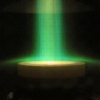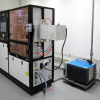Deposition of thick protection of function-performing coatings by radiofrequency plasma
Technology description
| The name of the technology: | Deposition of thick protection of function-performing coatings by radiofrequency plasma |
|---|---|
| Challenge: | Thermal spray technologies are a family of methods for deposition of relatively thick surface coatings. These are mostly used as a protection against mechanical (friction, wear, but also cavitation, etc.) or chemical damage (resistance to corrosion or acids), or even the effect of extreme temperatures up to thousands of degrees of Centigrade. However, the coatings produced by traditional thermal spray methods inherently exhibit several detrimental issues, with oxidation of the used materials being the most critical one, disallowing usage of, e.g., pure metals and many alloys. |
| Description: |
We offer a technology that allows deposition of relatively thick (0.1-3 mm) coatings for protection of components against mechanical, chemical or even thermal damage. As opposed to its generation-older predecessors the method operates under controlled atmosphere, thereby allowing to work with oxidation-sensitive materials such as pure metals or alloys. Unique in the Czech Republic, the radio frequency plasma operates in protective atmosphere (the major difference to the established, generation-older methods such as metallization, flame spray, atmospheric plasma or HVOF), thereby allowing to work with oxidation-sensitive materials (pure metals, alloys). Needless to say, this concept significantly broadens the applicability for industrial use. Main benefits: • Deposition of pure metals and alloys • Deposition of ceramic materials • Deposition of thick coatings (up to several millimeters), unattainable by methods such as PVD, CVD, MS, HIPIMS • Fast deposition (few minutes) |
| Commercial opportunity: |
Deposition of protective coatings onto loaded components is used in a broad range of industrial disciplines incliuding automotive industry, aviation, railways, aerospace, metallurgical and mining industry, energetics, chemical industry, medicine, engineering, food industry, paper industry and glassmaking. We offer the use of equipment for layer deposition on supplied components. Additionally, we provide the development of prototypes or functional samples through long-term, intensive collaboration, supported by detailed analyses available at our institution (microscopy, chemical analyses, mechanical properties, thermal properties). |
| IP protection status: | |
| Development status: |
Phase 3Corresponds with TRL 5 and TRL 6 Technology validation and implementing it in real environment. Testing the technology outside of the laboratory and its adjustment to external conditions.
|
| Partnering strategy: | Collaboration |
| More information: |
Technické parametry • Maximální výkon hořáku 15 kW (lze tavit i vysokotavitelné kovy, např. W) • Axiální podávání materiálu (rovnoměrnější prohřev) • Inertní až redukční atmosféra (Ar+H2) Odborný garant: Ing. Jan Čížek, Ph.D. z Ústavu fyziky plazmatu AV ČR, v.v.i. |
| Images: | |
| Categories: | Chemical and bioengineering |
| Institution: | Institute of plasma physics |
| Owner of a technology: | Ústav fyziky plazmatu AV ČR, v. v. i. |


